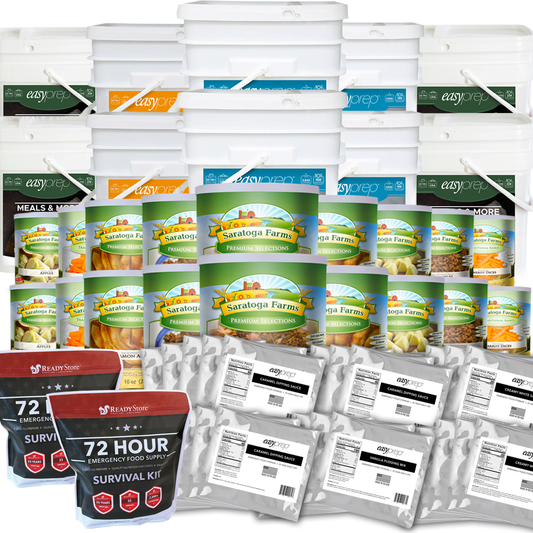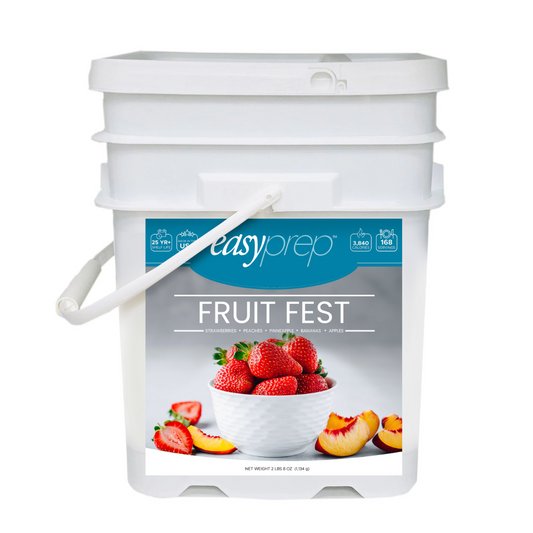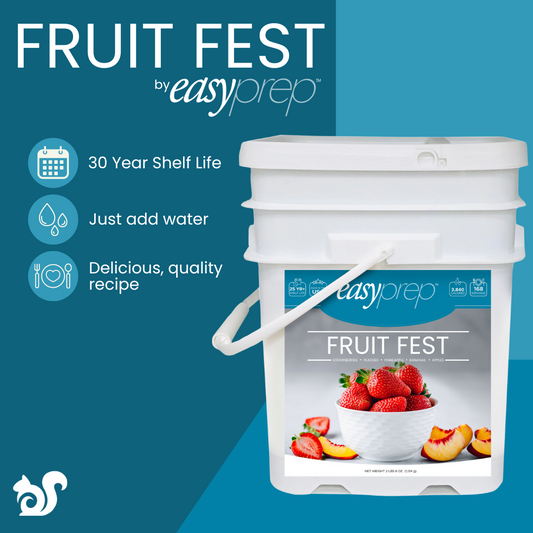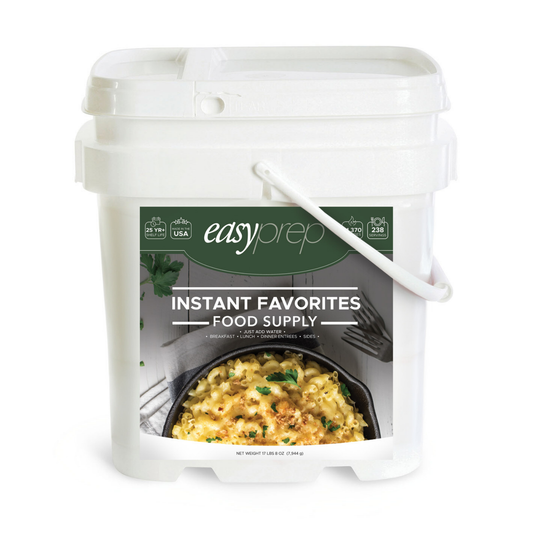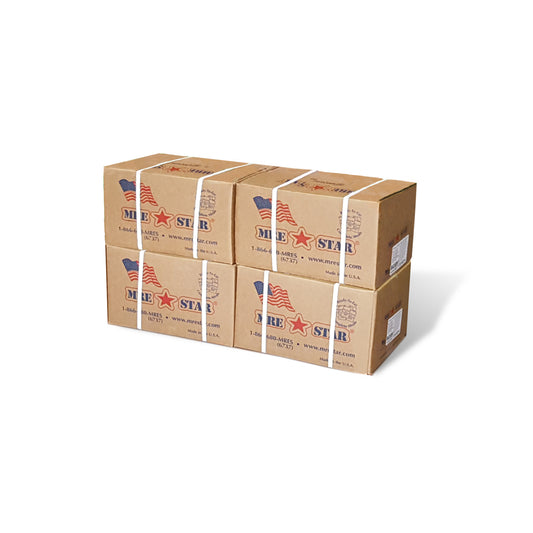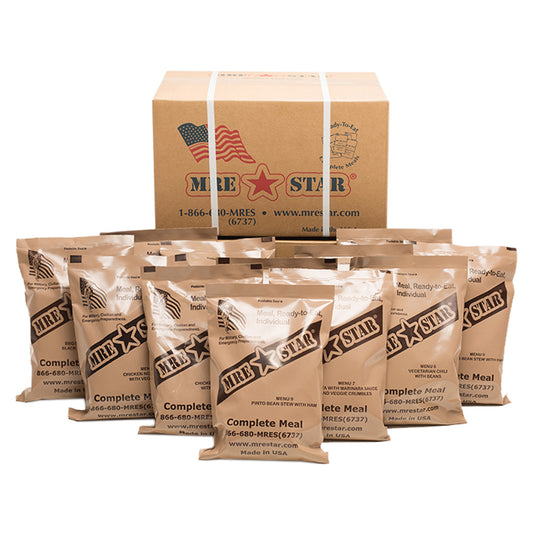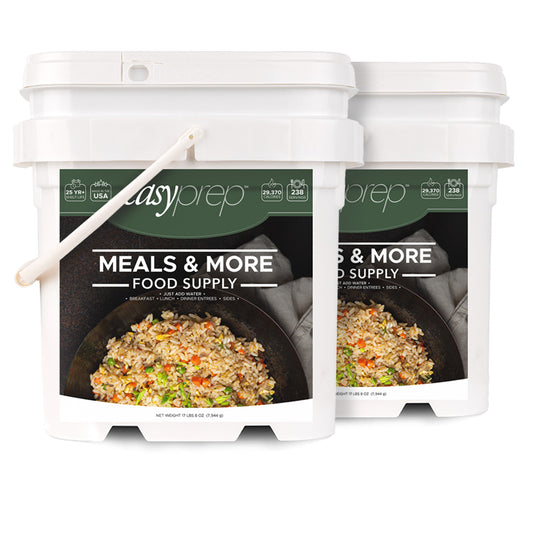Grow Your Own Medicinal Herbs
05 Apr 2013
Herbs have been used for thousands of years as a medicine to help your body heal naturally and effectively. Herbs such as Borage, Yarrow, Cayenne and more can be used to treat infections, fight blood loss, treat sickness and more. Check out this list of common herbs that you might use to help you in an emergency. Knowing how to use herbs to heal your body will help you become more self-sufficient and help you save money.
Before You Use Herbs
While herbs are natural, it does not mean they can be taken without caution. Medicinal Herbs can be very powerful and the compounds in them can interact with other drugs, medicines or herbs you may be taking so investigate before you start taking something new.
 As with anything, it is recommended to consult your physician before taking any medications, supplements or before making any significant changes to your dietary habits including the use of medicinal herbs. Side effects can occur with any of these herbs, the most common of which may be an allergic reaction. Again, consult a physician about using these herbs and proper dosing.
Children, women who are pregnant or hope to be pregnant, and those with compromised immunity should take caution before using these herbs. Prolonged use may lead to lower effectiveness.
Borage
Borage is one of the few plants with a true blue flower which is also edible. Borage leaves and flowers can be eaten fresh or dried. The leaves eaten fresh have a taste similar to cucumber and the flower a sweet taste. Natural herbalist use Borage to regulate the metabolism and hormone system, some claiming it helps with PMS and hot flashes.[1] It is also used as an anti-inflammatory as Borage is the highest known natural producer of gamma linolenic acid (GLA) and is medically accepted as “possibly effective” for the treatment of rheumatoid arthritis, lung function in ill patients and growth and development of premature babies.[2] Borage should not be taken if you have liver disease. Borage is typically made into tea or eaten fresh on salads. Plant borage in healthy, well-drained soil with full sun to partial shade exposure. Plant after the danger of frost has passed and plant in tight clusters so plants support each other as they grow (8 inches apart).
Calendula
Calendula is also called a pot marigold but, as a member of the daisy family, looks more like a daisy. The pedals of the calendula flower are edible and thought to work as an anti-viral and anti-inflammatory.[3] It has also been used to treat acne, constipation and abdominal cramps. Calendula has also been used topically and reported to help reduce swelling and bleeding including hemorrhoids and to help wounds heal faster.[4] Dried Calendula is found in many ointments. Calendula may cause drowsiness so take caution. Typically fresh flower pedals are added to salads, or eaten directly. Dried pedals are sometimes used to replace saffron. It is also applied directly to the skin.Plant in healthy, well-drained soil with full sun. Plant after the danger of frost has passed about 1/4 inch deep. Plant about 16 inches apart and dead head flowers to keep the plant blooming. If the heat of summer begins to make plant appear sick, cut back heavily and keep watered. Plant will bloom again as weather cools. Discuss with a doctor before taking and to establish dosage. University of Maryland recommends same and offers that historic Adult dosages have been:
• Infusion: 1 tsp (5 - 10 g) dried florets in 8 oz (250 mL) water; steep 10 - 15 minutes; drink 2 - 3 cups per day
• Fluid extract (1:1 in 40% alcohol): 0.5 - 1.0 mL 3 times per day
• Tincture (1:5 in 90% alcohol): 5 - 10 drops (1 - 2 mL) 3 times per day
• Ointment: 2 - 5% calendula; apply 3 - 4 times per day as needed
Cayenne
Cayenne hot peppers have been used as both a food and a medicine by Native Americans for thousands of years. Cayenne peppers can be eaten fresh when they are red or green, used in cooking, dried and ground into pepper flakes, or pulped-dried and then ground into a fine powder. The main active ingredient in Cayenne is Capsaicin which has been used to treat digestive problems, help with pain relief and help with circulatory problems. Capsaicin cream is used to treat arthritis, muscle pain and shingles. In addition, capsaicin is the key ingredient in personal defense sprays.[5]Start pepper plants indoors 7 weeks before the projected last frost date for your area and transplant when the soil has warmed and all danger of frost has passed in late spring. Peppers love warm soil, sunny locations and well-drained soil. Discuss with a doctor before taking and to establish dosage. University of Maryland recommends same and offers that historic Adult dosages have been:
• For shingles, psoriasis, arthritis, or muscle pain: Capsaicin cream (0.025 - 0.075% capsaicin) may be applied directly to the affected area up to 4 times a day. Pain may slightly increase at first, but then may get better over the next few days. Capsaicin should be applied regularly several times a day. It usually takes 3 - 7 days before you notice substantial pain relief.
NOTE: Be sure to completely wash your hands with soap and water after handling, water alone won’t remove capsaicin. If you are sensitive or want to ensure you wash as much capsaicin as possible try using a diluted vinegar solution.
Dandelion
Dandelion’s are a common site and frustration in our lawns, however, dandelions are entirely edible and are a good source of vitamins A, B complex, C and D[6]. They are also high in iron, potassium, and zinc. The most common historic uses for dandelion are as a diuretic, to treat mild digestive problems or increase appetite, and to treat liver issues. Some people have had allergic reactions to the pollen so try in small doses if you are unsure. Dandelion can be eaten fresh in salads, blanched (which will also remove some of the bitterness) or dried. The flowers are used by many to make dandelion wine. Young leaves are much less bitter than fully mature leaves. The root can be dry roasted over high heat until the color of a good roasted coffee bean and ground up as a caffeine free coffee or tea substitute. When harvesting roots, second year crops, harvested in the autumn will give you the best yield and best flavor. As you probably know, dandelions will grow well just about anywhere and if care is not taken will quickly spread. If you are cropping dandelions they will be best if planted in light soil to give the root good development. Constant care should be taken to collect seed heads before they spread. Discuss with a doctor before taking and to establish dosage. University of Maryland recommends same and offers that historic Adult dosages have been:
• Dried leaf infusion: 1 - 2 teaspoonfuls, 3 times daily. Pour hot water onto dried leaf and steep for 5 - 10 minutes. Drink as directed.
• Dried root decoction: 1/2 - 2 teaspoonfuls, 3 times daily. Place root into boiling water for 5 - 10 minutes. Strain and drink as directed.
• Leaf tincture (1:5) in 30% alcohol: 30 - 60 drops, 3 times daily
• Standardized powdered extract (4:1) leaf: 500 mg, 1 - 3 times daily
• Standardized powdered extract (4:1) root: 500 mg, 1 - 3 times daily
• Root tincture (1:2) fresh root in 45% alcohol: 30 - 60 drops, 3 times daily
Echinacea
Echinacea, also a member of the daisy family, is one of the most common herbs used today and has of recent been heavily promoted as a treatment to prevent or shorten the development of the common cold. Historically, Echinacea was used by the Native Americans to treat the symptoms of the cold such as headaches, sore throats, cough, and fever. Echinacea can be eaten fresh, dried, made into teas, juiced, or applied externally. Direct sow in spring under ¼ inch of well-drained soil in a sunny location. Echinacea is drought tolerant and can do well without lots of water once established. Discuss with a doctor before taking and to establish dosage. Suggested Adult dosages for general immune system stimulation, during colds, flu, upper respiratory tract infections, or bladder infections, choose from the following forms and take 3 times a day until you feel better, but not for more than 7 - 10 days:• 1 - 2 grams dried root or herb, as tea
• 2 - 3 mL of standardized tincture extract
• 6 - 9 mL of expressed juice (succus)
• 300 mg of standardized, powdered extract containing 4% phenolics
• Tincture (1:5): 1 - 3 mL (20 - 90 drops)
• Stabilized fresh extract: 0.75 mL (15 - 23 drops)
• Apply to wounds as needed
As with anything, it is recommended to consult your physician before taking any medications, supplements or before making any significant changes to your dietary habits including the use of medicinal herbs. Side effects can occur with any of these herbs, the most common of which may be an allergic reaction. Again, consult a physician about using these herbs and proper dosing.
Children, women who are pregnant or hope to be pregnant, and those with compromised immunity should take caution before using these herbs. Prolonged use may lead to lower effectiveness.
Borage
Borage is one of the few plants with a true blue flower which is also edible. Borage leaves and flowers can be eaten fresh or dried. The leaves eaten fresh have a taste similar to cucumber and the flower a sweet taste. Natural herbalist use Borage to regulate the metabolism and hormone system, some claiming it helps with PMS and hot flashes.[1] It is also used as an anti-inflammatory as Borage is the highest known natural producer of gamma linolenic acid (GLA) and is medically accepted as “possibly effective” for the treatment of rheumatoid arthritis, lung function in ill patients and growth and development of premature babies.[2] Borage should not be taken if you have liver disease. Borage is typically made into tea or eaten fresh on salads. Plant borage in healthy, well-drained soil with full sun to partial shade exposure. Plant after the danger of frost has passed and plant in tight clusters so plants support each other as they grow (8 inches apart).
Calendula
Calendula is also called a pot marigold but, as a member of the daisy family, looks more like a daisy. The pedals of the calendula flower are edible and thought to work as an anti-viral and anti-inflammatory.[3] It has also been used to treat acne, constipation and abdominal cramps. Calendula has also been used topically and reported to help reduce swelling and bleeding including hemorrhoids and to help wounds heal faster.[4] Dried Calendula is found in many ointments. Calendula may cause drowsiness so take caution. Typically fresh flower pedals are added to salads, or eaten directly. Dried pedals are sometimes used to replace saffron. It is also applied directly to the skin.Plant in healthy, well-drained soil with full sun. Plant after the danger of frost has passed about 1/4 inch deep. Plant about 16 inches apart and dead head flowers to keep the plant blooming. If the heat of summer begins to make plant appear sick, cut back heavily and keep watered. Plant will bloom again as weather cools. Discuss with a doctor before taking and to establish dosage. University of Maryland recommends same and offers that historic Adult dosages have been:
• Infusion: 1 tsp (5 - 10 g) dried florets in 8 oz (250 mL) water; steep 10 - 15 minutes; drink 2 - 3 cups per day
• Fluid extract (1:1 in 40% alcohol): 0.5 - 1.0 mL 3 times per day
• Tincture (1:5 in 90% alcohol): 5 - 10 drops (1 - 2 mL) 3 times per day
• Ointment: 2 - 5% calendula; apply 3 - 4 times per day as needed
Cayenne
Cayenne hot peppers have been used as both a food and a medicine by Native Americans for thousands of years. Cayenne peppers can be eaten fresh when they are red or green, used in cooking, dried and ground into pepper flakes, or pulped-dried and then ground into a fine powder. The main active ingredient in Cayenne is Capsaicin which has been used to treat digestive problems, help with pain relief and help with circulatory problems. Capsaicin cream is used to treat arthritis, muscle pain and shingles. In addition, capsaicin is the key ingredient in personal defense sprays.[5]Start pepper plants indoors 7 weeks before the projected last frost date for your area and transplant when the soil has warmed and all danger of frost has passed in late spring. Peppers love warm soil, sunny locations and well-drained soil. Discuss with a doctor before taking and to establish dosage. University of Maryland recommends same and offers that historic Adult dosages have been:
• For shingles, psoriasis, arthritis, or muscle pain: Capsaicin cream (0.025 - 0.075% capsaicin) may be applied directly to the affected area up to 4 times a day. Pain may slightly increase at first, but then may get better over the next few days. Capsaicin should be applied regularly several times a day. It usually takes 3 - 7 days before you notice substantial pain relief.
NOTE: Be sure to completely wash your hands with soap and water after handling, water alone won’t remove capsaicin. If you are sensitive or want to ensure you wash as much capsaicin as possible try using a diluted vinegar solution.
Dandelion
Dandelion’s are a common site and frustration in our lawns, however, dandelions are entirely edible and are a good source of vitamins A, B complex, C and D[6]. They are also high in iron, potassium, and zinc. The most common historic uses for dandelion are as a diuretic, to treat mild digestive problems or increase appetite, and to treat liver issues. Some people have had allergic reactions to the pollen so try in small doses if you are unsure. Dandelion can be eaten fresh in salads, blanched (which will also remove some of the bitterness) or dried. The flowers are used by many to make dandelion wine. Young leaves are much less bitter than fully mature leaves. The root can be dry roasted over high heat until the color of a good roasted coffee bean and ground up as a caffeine free coffee or tea substitute. When harvesting roots, second year crops, harvested in the autumn will give you the best yield and best flavor. As you probably know, dandelions will grow well just about anywhere and if care is not taken will quickly spread. If you are cropping dandelions they will be best if planted in light soil to give the root good development. Constant care should be taken to collect seed heads before they spread. Discuss with a doctor before taking and to establish dosage. University of Maryland recommends same and offers that historic Adult dosages have been:
• Dried leaf infusion: 1 - 2 teaspoonfuls, 3 times daily. Pour hot water onto dried leaf and steep for 5 - 10 minutes. Drink as directed.
• Dried root decoction: 1/2 - 2 teaspoonfuls, 3 times daily. Place root into boiling water for 5 - 10 minutes. Strain and drink as directed.
• Leaf tincture (1:5) in 30% alcohol: 30 - 60 drops, 3 times daily
• Standardized powdered extract (4:1) leaf: 500 mg, 1 - 3 times daily
• Standardized powdered extract (4:1) root: 500 mg, 1 - 3 times daily
• Root tincture (1:2) fresh root in 45% alcohol: 30 - 60 drops, 3 times daily
Echinacea
Echinacea, also a member of the daisy family, is one of the most common herbs used today and has of recent been heavily promoted as a treatment to prevent or shorten the development of the common cold. Historically, Echinacea was used by the Native Americans to treat the symptoms of the cold such as headaches, sore throats, cough, and fever. Echinacea can be eaten fresh, dried, made into teas, juiced, or applied externally. Direct sow in spring under ¼ inch of well-drained soil in a sunny location. Echinacea is drought tolerant and can do well without lots of water once established. Discuss with a doctor before taking and to establish dosage. Suggested Adult dosages for general immune system stimulation, during colds, flu, upper respiratory tract infections, or bladder infections, choose from the following forms and take 3 times a day until you feel better, but not for more than 7 - 10 days:• 1 - 2 grams dried root or herb, as tea
• 2 - 3 mL of standardized tincture extract
• 6 - 9 mL of expressed juice (succus)
• 300 mg of standardized, powdered extract containing 4% phenolics
• Tincture (1:5): 1 - 3 mL (20 - 90 drops)
• Stabilized fresh extract: 0.75 mL (15 - 23 drops)
• Apply to wounds as needed
 Fenugreek
Fenugreek is a very versatile and useful plant. The dried or fresh leaves are used as an herb, the seeds are a popular spice and the fresh leaves are edible. There is reasonable scientific support for the use of fenugreek in the treatment of diabetes.[7] It is also widely used to promote increased milk production in lactating women and increased libido in men. Leaves can be eaten fresh, sautéed, or dried. Seeds often roasted to open up their flavors and release some bitterness and are used whole or in a powdered form. Direct sow Fenugreek in a sunny location and thin as necessary with final planting about 4 inches apart. Seeds form in long brown pods that develop near the summer. Fenugreek is slow to grow in cold wet climates.
Hyssop
Hyssop has a very strong flavor which is similar to mint. Hyssop leaves are used in salads and soups. Hyssop also is used when cooking meat. Hyssop has traditionally been used to treat pulmonary conditions[8] and is most used as an expectorant. Hyssop tea is the usual means of taking in the herb with people either steeping the green tops or steeping the dried Hyssop flowers in hot water. Direct sow Hyssop seeds in the spring in a sunny well drained location about 12 inches apart. Hyssop is fairly hardy once established and can continue to be propagated from cuttings. Like other woody herbs Hyssop will need to be replaced every few years otherwise becomes too woody. Hyssop also will benefit from being cut back from time to time.
Lemon Balm
Lemon balm is a member of the mint family and has a strong lemony sent and flavor. It is frequently used to treat cold sores, promote relaxation and as a mosquito repellent. Research is also being conducted to look at lemon balm as possibly effective for Alzheimer’s. [9]Direct sow in spring or early fall in a cool and partially shaded location. Cover with 1/8th inch of soil. Trimming will result in additional branching producing a bushier more robust plant. As a member of the mint family, Lemon balm with self-propagate through its root structure and can quickly spread. Discuss with a doctor before taking and to establish dosage. University of Maryland recommends same and offers that historic Adult dosages have been:• Capsules: Take 300 - 500 mg dried lemon balm, 3 times daily or as needed.
• Tea: 1.5 - 4.5 grams (1/4 - 1 teaspoonful) of dried lemon balm herb in hot water. Steep and drink up to 4 times daily.
• Tincture: 60 drops of lemon balm daily
• Topical: Apply topical cream to affected area, 3 times daily or as directed.
• For cold sores or herpes sores, steep 2 - 4 teaspoonfuls of crushed leaf in 1 cup boiling water for 10 - 15 minutes. Cool. Apply tea with cotton balls to the sores throughout the day.
Lovage
Lovage is an extremely versatile plant. Its leaves are a very flavorful herb reminiscent of parsley and celery. The roots are a delicious vegetable that tastes great braised. The stalks can be eaten similar to celery. The seeds are a great spice that add tremendous flavor to bread. Because it is so similar in flavor to parsley and celery it is a common replacement for them in recipes. As a medicinal, lovage has been historically used to treat sore throats, treat indigestion and help rheumatism.[10] It has even been used in shoes as a deodorant Of course, it is also thought to be an aphrodisiac. Like many herbs lovage leaves will become a bit bitterer after the plant flowers so leaves are best harvested before flowering. Lovage is best direct sowed in the fall is a sunny to partially shady location. Lovage can become quite large so give it about 2 to 3 feet.
Yarrow
Yarrow is a well-known herb which has been which has been used for hundreds of years. One primary benefit of yarrow is that it is easy to grow and tolerates drought and less fertile soil better than many other plants. As an added benefit yarrow attracts many beneficial garden insects. Yarrow is most typically used for its ability to slow bleeding and is used on cuts and abrasions or bloody noses.[11] The leaves can also be dried or cooked in a soup. Sow yarrow seed under no more than 1/8th an inch of soil in the late spring. Yarrow prefers a sunny location and can tolerate dryer conditions than most other plants. Discuss with a doctor before taking and to establish dosage. Suggested dosages have been:• Capsules: Take 300 - 500 mg dried lemon balm, 3 times daily or as needed.
• Tea: 1.5 - 4.5 grams (1/4 - 1 teaspoonful) of dried yarrow flower in hot water. Steep and drink up to 4 times daily.
• Tincture: ¼ to ½ teaspoon – 2 to 5 times a day
• Topical: directly chew root for temporary relief from tooth ache. For wounds, apply a clean cloth soaked in a strong yarrow infusion directly to wound.
Your Recommendations
So, what herbs do you find most helpful? Comment below to share your knowledge and help others along their way.
[1] https://thehealthblog.us/2013/01/borage-flowers-that-help-heal.html
[2] US National Library of Medicine National Institute of Health: https://www.ncbi.nlm.nih.gov/pubmed/11710548
[3] US National Library of Medicine National Institute of Health: https://www.ncbi.nlm.nih.gov/pubmed/19374166
[4] Memorial Sloan-Kettering Cancer Center: https://www.mskcc.org/cancer-care/integrative-medicine/disclaimer?msk_disclaimer_herb=1&destination=%2Fcancer-care%2Fherb%2Fcalendula
[5] University of Maryland Medical Center: https://www.umm.edu/altmed/articles/cayenne--000230.htm
[6] https://nutritiondata.self.com/facts/vegetables-and-vegetable-products/2441/2
[7] US National Library of Medicine National Institute of Health https://www.ncbi.nlm.nih.gov/pubmed/19857068
[8] US Pharmacist Publication https://legacy.uspharmacist.com/oldformat.asp?url=newlook/files/Comp/hyssop.htm&pub_id=8&article_id=741
[9] https://alzheimers.about.com/od/alternativetreatments/a/Lemon_balm.htm
[10] Alberta Agriculture and Rural Development https://www1.agric.gov.ab.ca/$department/deptdocs.nsf/all/crop843?opendocument
[11] University of Maryland. School of Medicine. https://www.umm.edu/altmed/articles/yarrow-000282.htm
Fenugreek
Fenugreek is a very versatile and useful plant. The dried or fresh leaves are used as an herb, the seeds are a popular spice and the fresh leaves are edible. There is reasonable scientific support for the use of fenugreek in the treatment of diabetes.[7] It is also widely used to promote increased milk production in lactating women and increased libido in men. Leaves can be eaten fresh, sautéed, or dried. Seeds often roasted to open up their flavors and release some bitterness and are used whole or in a powdered form. Direct sow Fenugreek in a sunny location and thin as necessary with final planting about 4 inches apart. Seeds form in long brown pods that develop near the summer. Fenugreek is slow to grow in cold wet climates.
Hyssop
Hyssop has a very strong flavor which is similar to mint. Hyssop leaves are used in salads and soups. Hyssop also is used when cooking meat. Hyssop has traditionally been used to treat pulmonary conditions[8] and is most used as an expectorant. Hyssop tea is the usual means of taking in the herb with people either steeping the green tops or steeping the dried Hyssop flowers in hot water. Direct sow Hyssop seeds in the spring in a sunny well drained location about 12 inches apart. Hyssop is fairly hardy once established and can continue to be propagated from cuttings. Like other woody herbs Hyssop will need to be replaced every few years otherwise becomes too woody. Hyssop also will benefit from being cut back from time to time.
Lemon Balm
Lemon balm is a member of the mint family and has a strong lemony sent and flavor. It is frequently used to treat cold sores, promote relaxation and as a mosquito repellent. Research is also being conducted to look at lemon balm as possibly effective for Alzheimer’s. [9]Direct sow in spring or early fall in a cool and partially shaded location. Cover with 1/8th inch of soil. Trimming will result in additional branching producing a bushier more robust plant. As a member of the mint family, Lemon balm with self-propagate through its root structure and can quickly spread. Discuss with a doctor before taking and to establish dosage. University of Maryland recommends same and offers that historic Adult dosages have been:• Capsules: Take 300 - 500 mg dried lemon balm, 3 times daily or as needed.
• Tea: 1.5 - 4.5 grams (1/4 - 1 teaspoonful) of dried lemon balm herb in hot water. Steep and drink up to 4 times daily.
• Tincture: 60 drops of lemon balm daily
• Topical: Apply topical cream to affected area, 3 times daily or as directed.
• For cold sores or herpes sores, steep 2 - 4 teaspoonfuls of crushed leaf in 1 cup boiling water for 10 - 15 minutes. Cool. Apply tea with cotton balls to the sores throughout the day.
Lovage
Lovage is an extremely versatile plant. Its leaves are a very flavorful herb reminiscent of parsley and celery. The roots are a delicious vegetable that tastes great braised. The stalks can be eaten similar to celery. The seeds are a great spice that add tremendous flavor to bread. Because it is so similar in flavor to parsley and celery it is a common replacement for them in recipes. As a medicinal, lovage has been historically used to treat sore throats, treat indigestion and help rheumatism.[10] It has even been used in shoes as a deodorant Of course, it is also thought to be an aphrodisiac. Like many herbs lovage leaves will become a bit bitterer after the plant flowers so leaves are best harvested before flowering. Lovage is best direct sowed in the fall is a sunny to partially shady location. Lovage can become quite large so give it about 2 to 3 feet.
Yarrow
Yarrow is a well-known herb which has been which has been used for hundreds of years. One primary benefit of yarrow is that it is easy to grow and tolerates drought and less fertile soil better than many other plants. As an added benefit yarrow attracts many beneficial garden insects. Yarrow is most typically used for its ability to slow bleeding and is used on cuts and abrasions or bloody noses.[11] The leaves can also be dried or cooked in a soup. Sow yarrow seed under no more than 1/8th an inch of soil in the late spring. Yarrow prefers a sunny location and can tolerate dryer conditions than most other plants. Discuss with a doctor before taking and to establish dosage. Suggested dosages have been:• Capsules: Take 300 - 500 mg dried lemon balm, 3 times daily or as needed.
• Tea: 1.5 - 4.5 grams (1/4 - 1 teaspoonful) of dried yarrow flower in hot water. Steep and drink up to 4 times daily.
• Tincture: ¼ to ½ teaspoon – 2 to 5 times a day
• Topical: directly chew root for temporary relief from tooth ache. For wounds, apply a clean cloth soaked in a strong yarrow infusion directly to wound.
Your Recommendations
So, what herbs do you find most helpful? Comment below to share your knowledge and help others along their way.
[1] https://thehealthblog.us/2013/01/borage-flowers-that-help-heal.html
[2] US National Library of Medicine National Institute of Health: https://www.ncbi.nlm.nih.gov/pubmed/11710548
[3] US National Library of Medicine National Institute of Health: https://www.ncbi.nlm.nih.gov/pubmed/19374166
[4] Memorial Sloan-Kettering Cancer Center: https://www.mskcc.org/cancer-care/integrative-medicine/disclaimer?msk_disclaimer_herb=1&destination=%2Fcancer-care%2Fherb%2Fcalendula
[5] University of Maryland Medical Center: https://www.umm.edu/altmed/articles/cayenne--000230.htm
[6] https://nutritiondata.self.com/facts/vegetables-and-vegetable-products/2441/2
[7] US National Library of Medicine National Institute of Health https://www.ncbi.nlm.nih.gov/pubmed/19857068
[8] US Pharmacist Publication https://legacy.uspharmacist.com/oldformat.asp?url=newlook/files/Comp/hyssop.htm&pub_id=8&article_id=741
[9] https://alzheimers.about.com/od/alternativetreatments/a/Lemon_balm.htm
[10] Alberta Agriculture and Rural Development https://www1.agric.gov.ab.ca/$department/deptdocs.nsf/all/crop843?opendocument
[11] University of Maryland. School of Medicine. https://www.umm.edu/altmed/articles/yarrow-000282.htm
 As with anything, it is recommended to consult your physician before taking any medications, supplements or before making any significant changes to your dietary habits including the use of medicinal herbs. Side effects can occur with any of these herbs, the most common of which may be an allergic reaction. Again, consult a physician about using these herbs and proper dosing.
Children, women who are pregnant or hope to be pregnant, and those with compromised immunity should take caution before using these herbs. Prolonged use may lead to lower effectiveness.
Borage
Borage is one of the few plants with a true blue flower which is also edible. Borage leaves and flowers can be eaten fresh or dried. The leaves eaten fresh have a taste similar to cucumber and the flower a sweet taste. Natural herbalist use Borage to regulate the metabolism and hormone system, some claiming it helps with PMS and hot flashes.[1] It is also used as an anti-inflammatory as Borage is the highest known natural producer of gamma linolenic acid (GLA) and is medically accepted as “possibly effective” for the treatment of rheumatoid arthritis, lung function in ill patients and growth and development of premature babies.[2] Borage should not be taken if you have liver disease. Borage is typically made into tea or eaten fresh on salads. Plant borage in healthy, well-drained soil with full sun to partial shade exposure. Plant after the danger of frost has passed and plant in tight clusters so plants support each other as they grow (8 inches apart).
Calendula
Calendula is also called a pot marigold but, as a member of the daisy family, looks more like a daisy. The pedals of the calendula flower are edible and thought to work as an anti-viral and anti-inflammatory.[3] It has also been used to treat acne, constipation and abdominal cramps. Calendula has also been used topically and reported to help reduce swelling and bleeding including hemorrhoids and to help wounds heal faster.[4] Dried Calendula is found in many ointments. Calendula may cause drowsiness so take caution. Typically fresh flower pedals are added to salads, or eaten directly. Dried pedals are sometimes used to replace saffron. It is also applied directly to the skin.Plant in healthy, well-drained soil with full sun. Plant after the danger of frost has passed about 1/4 inch deep. Plant about 16 inches apart and dead head flowers to keep the plant blooming. If the heat of summer begins to make plant appear sick, cut back heavily and keep watered. Plant will bloom again as weather cools. Discuss with a doctor before taking and to establish dosage. University of Maryland recommends same and offers that historic Adult dosages have been:
• Infusion: 1 tsp (5 - 10 g) dried florets in 8 oz (250 mL) water; steep 10 - 15 minutes; drink 2 - 3 cups per day
• Fluid extract (1:1 in 40% alcohol): 0.5 - 1.0 mL 3 times per day
• Tincture (1:5 in 90% alcohol): 5 - 10 drops (1 - 2 mL) 3 times per day
• Ointment: 2 - 5% calendula; apply 3 - 4 times per day as needed
Cayenne
Cayenne hot peppers have been used as both a food and a medicine by Native Americans for thousands of years. Cayenne peppers can be eaten fresh when they are red or green, used in cooking, dried and ground into pepper flakes, or pulped-dried and then ground into a fine powder. The main active ingredient in Cayenne is Capsaicin which has been used to treat digestive problems, help with pain relief and help with circulatory problems. Capsaicin cream is used to treat arthritis, muscle pain and shingles. In addition, capsaicin is the key ingredient in personal defense sprays.[5]Start pepper plants indoors 7 weeks before the projected last frost date for your area and transplant when the soil has warmed and all danger of frost has passed in late spring. Peppers love warm soil, sunny locations and well-drained soil. Discuss with a doctor before taking and to establish dosage. University of Maryland recommends same and offers that historic Adult dosages have been:
• For shingles, psoriasis, arthritis, or muscle pain: Capsaicin cream (0.025 - 0.075% capsaicin) may be applied directly to the affected area up to 4 times a day. Pain may slightly increase at first, but then may get better over the next few days. Capsaicin should be applied regularly several times a day. It usually takes 3 - 7 days before you notice substantial pain relief.
NOTE: Be sure to completely wash your hands with soap and water after handling, water alone won’t remove capsaicin. If you are sensitive or want to ensure you wash as much capsaicin as possible try using a diluted vinegar solution.
Dandelion
Dandelion’s are a common site and frustration in our lawns, however, dandelions are entirely edible and are a good source of vitamins A, B complex, C and D[6]. They are also high in iron, potassium, and zinc. The most common historic uses for dandelion are as a diuretic, to treat mild digestive problems or increase appetite, and to treat liver issues. Some people have had allergic reactions to the pollen so try in small doses if you are unsure. Dandelion can be eaten fresh in salads, blanched (which will also remove some of the bitterness) or dried. The flowers are used by many to make dandelion wine. Young leaves are much less bitter than fully mature leaves. The root can be dry roasted over high heat until the color of a good roasted coffee bean and ground up as a caffeine free coffee or tea substitute. When harvesting roots, second year crops, harvested in the autumn will give you the best yield and best flavor. As you probably know, dandelions will grow well just about anywhere and if care is not taken will quickly spread. If you are cropping dandelions they will be best if planted in light soil to give the root good development. Constant care should be taken to collect seed heads before they spread. Discuss with a doctor before taking and to establish dosage. University of Maryland recommends same and offers that historic Adult dosages have been:
• Dried leaf infusion: 1 - 2 teaspoonfuls, 3 times daily. Pour hot water onto dried leaf and steep for 5 - 10 minutes. Drink as directed.
• Dried root decoction: 1/2 - 2 teaspoonfuls, 3 times daily. Place root into boiling water for 5 - 10 minutes. Strain and drink as directed.
• Leaf tincture (1:5) in 30% alcohol: 30 - 60 drops, 3 times daily
• Standardized powdered extract (4:1) leaf: 500 mg, 1 - 3 times daily
• Standardized powdered extract (4:1) root: 500 mg, 1 - 3 times daily
• Root tincture (1:2) fresh root in 45% alcohol: 30 - 60 drops, 3 times daily
Echinacea
Echinacea, also a member of the daisy family, is one of the most common herbs used today and has of recent been heavily promoted as a treatment to prevent or shorten the development of the common cold. Historically, Echinacea was used by the Native Americans to treat the symptoms of the cold such as headaches, sore throats, cough, and fever. Echinacea can be eaten fresh, dried, made into teas, juiced, or applied externally. Direct sow in spring under ¼ inch of well-drained soil in a sunny location. Echinacea is drought tolerant and can do well without lots of water once established. Discuss with a doctor before taking and to establish dosage. Suggested Adult dosages for general immune system stimulation, during colds, flu, upper respiratory tract infections, or bladder infections, choose from the following forms and take 3 times a day until you feel better, but not for more than 7 - 10 days:• 1 - 2 grams dried root or herb, as tea
• 2 - 3 mL of standardized tincture extract
• 6 - 9 mL of expressed juice (succus)
• 300 mg of standardized, powdered extract containing 4% phenolics
• Tincture (1:5): 1 - 3 mL (20 - 90 drops)
• Stabilized fresh extract: 0.75 mL (15 - 23 drops)
• Apply to wounds as needed
As with anything, it is recommended to consult your physician before taking any medications, supplements or before making any significant changes to your dietary habits including the use of medicinal herbs. Side effects can occur with any of these herbs, the most common of which may be an allergic reaction. Again, consult a physician about using these herbs and proper dosing.
Children, women who are pregnant or hope to be pregnant, and those with compromised immunity should take caution before using these herbs. Prolonged use may lead to lower effectiveness.
Borage
Borage is one of the few plants with a true blue flower which is also edible. Borage leaves and flowers can be eaten fresh or dried. The leaves eaten fresh have a taste similar to cucumber and the flower a sweet taste. Natural herbalist use Borage to regulate the metabolism and hormone system, some claiming it helps with PMS and hot flashes.[1] It is also used as an anti-inflammatory as Borage is the highest known natural producer of gamma linolenic acid (GLA) and is medically accepted as “possibly effective” for the treatment of rheumatoid arthritis, lung function in ill patients and growth and development of premature babies.[2] Borage should not be taken if you have liver disease. Borage is typically made into tea or eaten fresh on salads. Plant borage in healthy, well-drained soil with full sun to partial shade exposure. Plant after the danger of frost has passed and plant in tight clusters so plants support each other as they grow (8 inches apart).
Calendula
Calendula is also called a pot marigold but, as a member of the daisy family, looks more like a daisy. The pedals of the calendula flower are edible and thought to work as an anti-viral and anti-inflammatory.[3] It has also been used to treat acne, constipation and abdominal cramps. Calendula has also been used topically and reported to help reduce swelling and bleeding including hemorrhoids and to help wounds heal faster.[4] Dried Calendula is found in many ointments. Calendula may cause drowsiness so take caution. Typically fresh flower pedals are added to salads, or eaten directly. Dried pedals are sometimes used to replace saffron. It is also applied directly to the skin.Plant in healthy, well-drained soil with full sun. Plant after the danger of frost has passed about 1/4 inch deep. Plant about 16 inches apart and dead head flowers to keep the plant blooming. If the heat of summer begins to make plant appear sick, cut back heavily and keep watered. Plant will bloom again as weather cools. Discuss with a doctor before taking and to establish dosage. University of Maryland recommends same and offers that historic Adult dosages have been:
• Infusion: 1 tsp (5 - 10 g) dried florets in 8 oz (250 mL) water; steep 10 - 15 minutes; drink 2 - 3 cups per day
• Fluid extract (1:1 in 40% alcohol): 0.5 - 1.0 mL 3 times per day
• Tincture (1:5 in 90% alcohol): 5 - 10 drops (1 - 2 mL) 3 times per day
• Ointment: 2 - 5% calendula; apply 3 - 4 times per day as needed
Cayenne
Cayenne hot peppers have been used as both a food and a medicine by Native Americans for thousands of years. Cayenne peppers can be eaten fresh when they are red or green, used in cooking, dried and ground into pepper flakes, or pulped-dried and then ground into a fine powder. The main active ingredient in Cayenne is Capsaicin which has been used to treat digestive problems, help with pain relief and help with circulatory problems. Capsaicin cream is used to treat arthritis, muscle pain and shingles. In addition, capsaicin is the key ingredient in personal defense sprays.[5]Start pepper plants indoors 7 weeks before the projected last frost date for your area and transplant when the soil has warmed and all danger of frost has passed in late spring. Peppers love warm soil, sunny locations and well-drained soil. Discuss with a doctor before taking and to establish dosage. University of Maryland recommends same and offers that historic Adult dosages have been:
• For shingles, psoriasis, arthritis, or muscle pain: Capsaicin cream (0.025 - 0.075% capsaicin) may be applied directly to the affected area up to 4 times a day. Pain may slightly increase at first, but then may get better over the next few days. Capsaicin should be applied regularly several times a day. It usually takes 3 - 7 days before you notice substantial pain relief.
NOTE: Be sure to completely wash your hands with soap and water after handling, water alone won’t remove capsaicin. If you are sensitive or want to ensure you wash as much capsaicin as possible try using a diluted vinegar solution.
Dandelion
Dandelion’s are a common site and frustration in our lawns, however, dandelions are entirely edible and are a good source of vitamins A, B complex, C and D[6]. They are also high in iron, potassium, and zinc. The most common historic uses for dandelion are as a diuretic, to treat mild digestive problems or increase appetite, and to treat liver issues. Some people have had allergic reactions to the pollen so try in small doses if you are unsure. Dandelion can be eaten fresh in salads, blanched (which will also remove some of the bitterness) or dried. The flowers are used by many to make dandelion wine. Young leaves are much less bitter than fully mature leaves. The root can be dry roasted over high heat until the color of a good roasted coffee bean and ground up as a caffeine free coffee or tea substitute. When harvesting roots, second year crops, harvested in the autumn will give you the best yield and best flavor. As you probably know, dandelions will grow well just about anywhere and if care is not taken will quickly spread. If you are cropping dandelions they will be best if planted in light soil to give the root good development. Constant care should be taken to collect seed heads before they spread. Discuss with a doctor before taking and to establish dosage. University of Maryland recommends same and offers that historic Adult dosages have been:
• Dried leaf infusion: 1 - 2 teaspoonfuls, 3 times daily. Pour hot water onto dried leaf and steep for 5 - 10 minutes. Drink as directed.
• Dried root decoction: 1/2 - 2 teaspoonfuls, 3 times daily. Place root into boiling water for 5 - 10 minutes. Strain and drink as directed.
• Leaf tincture (1:5) in 30% alcohol: 30 - 60 drops, 3 times daily
• Standardized powdered extract (4:1) leaf: 500 mg, 1 - 3 times daily
• Standardized powdered extract (4:1) root: 500 mg, 1 - 3 times daily
• Root tincture (1:2) fresh root in 45% alcohol: 30 - 60 drops, 3 times daily
Echinacea
Echinacea, also a member of the daisy family, is one of the most common herbs used today and has of recent been heavily promoted as a treatment to prevent or shorten the development of the common cold. Historically, Echinacea was used by the Native Americans to treat the symptoms of the cold such as headaches, sore throats, cough, and fever. Echinacea can be eaten fresh, dried, made into teas, juiced, or applied externally. Direct sow in spring under ¼ inch of well-drained soil in a sunny location. Echinacea is drought tolerant and can do well without lots of water once established. Discuss with a doctor before taking and to establish dosage. Suggested Adult dosages for general immune system stimulation, during colds, flu, upper respiratory tract infections, or bladder infections, choose from the following forms and take 3 times a day until you feel better, but not for more than 7 - 10 days:• 1 - 2 grams dried root or herb, as tea
• 2 - 3 mL of standardized tincture extract
• 6 - 9 mL of expressed juice (succus)
• 300 mg of standardized, powdered extract containing 4% phenolics
• Tincture (1:5): 1 - 3 mL (20 - 90 drops)
• Stabilized fresh extract: 0.75 mL (15 - 23 drops)
• Apply to wounds as needed
 Fenugreek
Fenugreek is a very versatile and useful plant. The dried or fresh leaves are used as an herb, the seeds are a popular spice and the fresh leaves are edible. There is reasonable scientific support for the use of fenugreek in the treatment of diabetes.[7] It is also widely used to promote increased milk production in lactating women and increased libido in men. Leaves can be eaten fresh, sautéed, or dried. Seeds often roasted to open up their flavors and release some bitterness and are used whole or in a powdered form. Direct sow Fenugreek in a sunny location and thin as necessary with final planting about 4 inches apart. Seeds form in long brown pods that develop near the summer. Fenugreek is slow to grow in cold wet climates.
Hyssop
Hyssop has a very strong flavor which is similar to mint. Hyssop leaves are used in salads and soups. Hyssop also is used when cooking meat. Hyssop has traditionally been used to treat pulmonary conditions[8] and is most used as an expectorant. Hyssop tea is the usual means of taking in the herb with people either steeping the green tops or steeping the dried Hyssop flowers in hot water. Direct sow Hyssop seeds in the spring in a sunny well drained location about 12 inches apart. Hyssop is fairly hardy once established and can continue to be propagated from cuttings. Like other woody herbs Hyssop will need to be replaced every few years otherwise becomes too woody. Hyssop also will benefit from being cut back from time to time.
Lemon Balm
Lemon balm is a member of the mint family and has a strong lemony sent and flavor. It is frequently used to treat cold sores, promote relaxation and as a mosquito repellent. Research is also being conducted to look at lemon balm as possibly effective for Alzheimer’s. [9]Direct sow in spring or early fall in a cool and partially shaded location. Cover with 1/8th inch of soil. Trimming will result in additional branching producing a bushier more robust plant. As a member of the mint family, Lemon balm with self-propagate through its root structure and can quickly spread. Discuss with a doctor before taking and to establish dosage. University of Maryland recommends same and offers that historic Adult dosages have been:• Capsules: Take 300 - 500 mg dried lemon balm, 3 times daily or as needed.
• Tea: 1.5 - 4.5 grams (1/4 - 1 teaspoonful) of dried lemon balm herb in hot water. Steep and drink up to 4 times daily.
• Tincture: 60 drops of lemon balm daily
• Topical: Apply topical cream to affected area, 3 times daily or as directed.
• For cold sores or herpes sores, steep 2 - 4 teaspoonfuls of crushed leaf in 1 cup boiling water for 10 - 15 minutes. Cool. Apply tea with cotton balls to the sores throughout the day.
Lovage
Lovage is an extremely versatile plant. Its leaves are a very flavorful herb reminiscent of parsley and celery. The roots are a delicious vegetable that tastes great braised. The stalks can be eaten similar to celery. The seeds are a great spice that add tremendous flavor to bread. Because it is so similar in flavor to parsley and celery it is a common replacement for them in recipes. As a medicinal, lovage has been historically used to treat sore throats, treat indigestion and help rheumatism.[10] It has even been used in shoes as a deodorant Of course, it is also thought to be an aphrodisiac. Like many herbs lovage leaves will become a bit bitterer after the plant flowers so leaves are best harvested before flowering. Lovage is best direct sowed in the fall is a sunny to partially shady location. Lovage can become quite large so give it about 2 to 3 feet.
Yarrow
Yarrow is a well-known herb which has been which has been used for hundreds of years. One primary benefit of yarrow is that it is easy to grow and tolerates drought and less fertile soil better than many other plants. As an added benefit yarrow attracts many beneficial garden insects. Yarrow is most typically used for its ability to slow bleeding and is used on cuts and abrasions or bloody noses.[11] The leaves can also be dried or cooked in a soup. Sow yarrow seed under no more than 1/8th an inch of soil in the late spring. Yarrow prefers a sunny location and can tolerate dryer conditions than most other plants. Discuss with a doctor before taking and to establish dosage. Suggested dosages have been:• Capsules: Take 300 - 500 mg dried lemon balm, 3 times daily or as needed.
• Tea: 1.5 - 4.5 grams (1/4 - 1 teaspoonful) of dried yarrow flower in hot water. Steep and drink up to 4 times daily.
• Tincture: ¼ to ½ teaspoon – 2 to 5 times a day
• Topical: directly chew root for temporary relief from tooth ache. For wounds, apply a clean cloth soaked in a strong yarrow infusion directly to wound.
Your Recommendations
So, what herbs do you find most helpful? Comment below to share your knowledge and help others along their way.
[1] https://thehealthblog.us/2013/01/borage-flowers-that-help-heal.html
[2] US National Library of Medicine National Institute of Health: https://www.ncbi.nlm.nih.gov/pubmed/11710548
[3] US National Library of Medicine National Institute of Health: https://www.ncbi.nlm.nih.gov/pubmed/19374166
[4] Memorial Sloan-Kettering Cancer Center: https://www.mskcc.org/cancer-care/integrative-medicine/disclaimer?msk_disclaimer_herb=1&destination=%2Fcancer-care%2Fherb%2Fcalendula
[5] University of Maryland Medical Center: https://www.umm.edu/altmed/articles/cayenne--000230.htm
[6] https://nutritiondata.self.com/facts/vegetables-and-vegetable-products/2441/2
[7] US National Library of Medicine National Institute of Health https://www.ncbi.nlm.nih.gov/pubmed/19857068
[8] US Pharmacist Publication https://legacy.uspharmacist.com/oldformat.asp?url=newlook/files/Comp/hyssop.htm&pub_id=8&article_id=741
[9] https://alzheimers.about.com/od/alternativetreatments/a/Lemon_balm.htm
[10] Alberta Agriculture and Rural Development https://www1.agric.gov.ab.ca/$department/deptdocs.nsf/all/crop843?opendocument
[11] University of Maryland. School of Medicine. https://www.umm.edu/altmed/articles/yarrow-000282.htm
Fenugreek
Fenugreek is a very versatile and useful plant. The dried or fresh leaves are used as an herb, the seeds are a popular spice and the fresh leaves are edible. There is reasonable scientific support for the use of fenugreek in the treatment of diabetes.[7] It is also widely used to promote increased milk production in lactating women and increased libido in men. Leaves can be eaten fresh, sautéed, or dried. Seeds often roasted to open up their flavors and release some bitterness and are used whole or in a powdered form. Direct sow Fenugreek in a sunny location and thin as necessary with final planting about 4 inches apart. Seeds form in long brown pods that develop near the summer. Fenugreek is slow to grow in cold wet climates.
Hyssop
Hyssop has a very strong flavor which is similar to mint. Hyssop leaves are used in salads and soups. Hyssop also is used when cooking meat. Hyssop has traditionally been used to treat pulmonary conditions[8] and is most used as an expectorant. Hyssop tea is the usual means of taking in the herb with people either steeping the green tops or steeping the dried Hyssop flowers in hot water. Direct sow Hyssop seeds in the spring in a sunny well drained location about 12 inches apart. Hyssop is fairly hardy once established and can continue to be propagated from cuttings. Like other woody herbs Hyssop will need to be replaced every few years otherwise becomes too woody. Hyssop also will benefit from being cut back from time to time.
Lemon Balm
Lemon balm is a member of the mint family and has a strong lemony sent and flavor. It is frequently used to treat cold sores, promote relaxation and as a mosquito repellent. Research is also being conducted to look at lemon balm as possibly effective for Alzheimer’s. [9]Direct sow in spring or early fall in a cool and partially shaded location. Cover with 1/8th inch of soil. Trimming will result in additional branching producing a bushier more robust plant. As a member of the mint family, Lemon balm with self-propagate through its root structure and can quickly spread. Discuss with a doctor before taking and to establish dosage. University of Maryland recommends same and offers that historic Adult dosages have been:• Capsules: Take 300 - 500 mg dried lemon balm, 3 times daily or as needed.
• Tea: 1.5 - 4.5 grams (1/4 - 1 teaspoonful) of dried lemon balm herb in hot water. Steep and drink up to 4 times daily.
• Tincture: 60 drops of lemon balm daily
• Topical: Apply topical cream to affected area, 3 times daily or as directed.
• For cold sores or herpes sores, steep 2 - 4 teaspoonfuls of crushed leaf in 1 cup boiling water for 10 - 15 minutes. Cool. Apply tea with cotton balls to the sores throughout the day.
Lovage
Lovage is an extremely versatile plant. Its leaves are a very flavorful herb reminiscent of parsley and celery. The roots are a delicious vegetable that tastes great braised. The stalks can be eaten similar to celery. The seeds are a great spice that add tremendous flavor to bread. Because it is so similar in flavor to parsley and celery it is a common replacement for them in recipes. As a medicinal, lovage has been historically used to treat sore throats, treat indigestion and help rheumatism.[10] It has even been used in shoes as a deodorant Of course, it is also thought to be an aphrodisiac. Like many herbs lovage leaves will become a bit bitterer after the plant flowers so leaves are best harvested before flowering. Lovage is best direct sowed in the fall is a sunny to partially shady location. Lovage can become quite large so give it about 2 to 3 feet.
Yarrow
Yarrow is a well-known herb which has been which has been used for hundreds of years. One primary benefit of yarrow is that it is easy to grow and tolerates drought and less fertile soil better than many other plants. As an added benefit yarrow attracts many beneficial garden insects. Yarrow is most typically used for its ability to slow bleeding and is used on cuts and abrasions or bloody noses.[11] The leaves can also be dried or cooked in a soup. Sow yarrow seed under no more than 1/8th an inch of soil in the late spring. Yarrow prefers a sunny location and can tolerate dryer conditions than most other plants. Discuss with a doctor before taking and to establish dosage. Suggested dosages have been:• Capsules: Take 300 - 500 mg dried lemon balm, 3 times daily or as needed.
• Tea: 1.5 - 4.5 grams (1/4 - 1 teaspoonful) of dried yarrow flower in hot water. Steep and drink up to 4 times daily.
• Tincture: ¼ to ½ teaspoon – 2 to 5 times a day
• Topical: directly chew root for temporary relief from tooth ache. For wounds, apply a clean cloth soaked in a strong yarrow infusion directly to wound.
Your Recommendations
So, what herbs do you find most helpful? Comment below to share your knowledge and help others along their way.
[1] https://thehealthblog.us/2013/01/borage-flowers-that-help-heal.html
[2] US National Library of Medicine National Institute of Health: https://www.ncbi.nlm.nih.gov/pubmed/11710548
[3] US National Library of Medicine National Institute of Health: https://www.ncbi.nlm.nih.gov/pubmed/19374166
[4] Memorial Sloan-Kettering Cancer Center: https://www.mskcc.org/cancer-care/integrative-medicine/disclaimer?msk_disclaimer_herb=1&destination=%2Fcancer-care%2Fherb%2Fcalendula
[5] University of Maryland Medical Center: https://www.umm.edu/altmed/articles/cayenne--000230.htm
[6] https://nutritiondata.self.com/facts/vegetables-and-vegetable-products/2441/2
[7] US National Library of Medicine National Institute of Health https://www.ncbi.nlm.nih.gov/pubmed/19857068
[8] US Pharmacist Publication https://legacy.uspharmacist.com/oldformat.asp?url=newlook/files/Comp/hyssop.htm&pub_id=8&article_id=741
[9] https://alzheimers.about.com/od/alternativetreatments/a/Lemon_balm.htm
[10] Alberta Agriculture and Rural Development https://www1.agric.gov.ab.ca/$department/deptdocs.nsf/all/crop843?opendocument
[11] University of Maryland. School of Medicine. https://www.umm.edu/altmed/articles/yarrow-000282.htm


